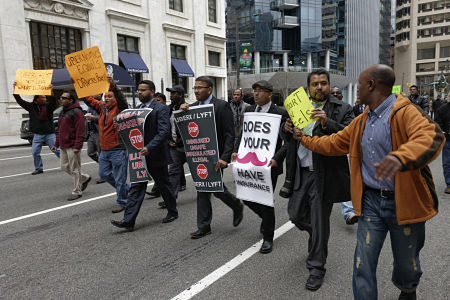Ride-hail newcomer and industry leader Uber is now valued at more than $64 billion and has changed the personal transportation landscape.
Those gains, however, have come largely at the expense of a taxicab and limousine industry that is reeling.

During the first six months of 2015, pickups for taxis in Manhattan dropped 10 percent to 77 million – down from 85.5 million the year before, according to an analysis of trip data. Manhattan accounts for an estimated 90 percent of the taxi business in New York City.
The iconic yellow taxi company is fighting back.
The Metropolitan Taxicab Board of Trade (MTBOT) recently launched a $1 million advertising campaign designed to lure back drivers who abandoned their taxis for Uber fares.
The trade group represents 5,500 taxi owners and leases cabs to more than 20,000 drivers.
Part of the campaign includes 1,500 ads on MTA buses targeting drivers, and ads in local ethnic newspapers that represent twenty countries. It is also spearheading a social media campaign on Facebook.
The ads on the outside of MTA buses say "drive yellow, earn green."
The trade group says having to sell the iconic yellow taxi brand in the Big Apple is a little hard to swallow but the industry is in survival mode.
“There are other choices for both drivers and for passengers so we need to communicate the clear benefits of both driving yellow and riding yellow -- and that is what the advertising campaign is all about," said spokesman Michael Woloz.
"We are seeing more and more drivers returning to the industry and in many cases, entering the yellow cab industry for the first time. Yellow is back,” he added.
MTBOT’s campaign comes on the heels of a decision by the Taxi and Limousine Commission (TLC) to allow drivers to use one license for a yellow cab or for-hire vehicle. Previously, they were required to have separate licenses.
TLC says the change will provide more flexibility for both drivers and riders.
"Our goal of increasing mobility between sectors provides benefits for passengers," said TLC Commissioner Meera Joshi. "But it also applies to drivers, and to that end, the combined medallion/for-hire vehicle license makes it easier for experienced drivers to work across both sectors and reap the economic benefits of options."
The MTBOT campaign is a direct response to Uber’s 27,000 drivers now operating on New York City streets, up from 14,000 in March of this year.
According to the TLC, there are 13,500 yellow cabs in the city and another 7,00 green cabs serving the outer boroughs and upper Manhattan.
"Choice is a good thing. It's good customers can choose to have the transportation option that works for them," said Michael O’Loughlin with the group Cab Riders United. "In the absence of competition, businesses get lazy or sloppy. It's good to see they're aiming to have the highest standards possible."
MTBOT launched a resource center in Long Island City, which helps drivers transition from companies like Uber back to yellow cabs, and has created a website called driveyellow.nyc. The center is staffed to help drivers with issues that include traffic tickets and a free defensive driving course.
"Yellow taxi drivers are the lifeblood of this city, and they have one of the toughest jobs in the city," said Jean Barrett, executive director of the group. "Navigating all the regulatory hurdles can be time-consuming, and in some cases confusing."
The taxi companies are getting an assist from two new apps, Arro and Way2Ride, which mimic Uber’s app and allow riders to hail and pay for a taxi from their smartphone. Though the apps are independent, the taxi companies are making them seamless for drivers and riders.
"Sometimes you have to cooperate with your competitors," said Evan Rawley, associate professor at Columbia University, who tracks Uber and the taxi industry. "This is the kind of situation where they were just going to be overwhelmed by Uber if they didn't do something to work together."
